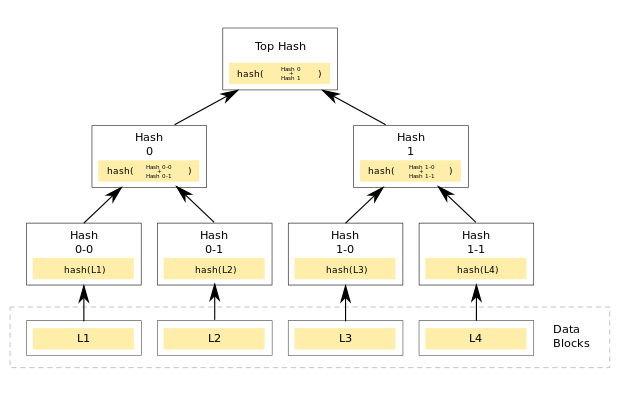The main goal of this lecture is to introduce students to merkalised storage solutions and how they are used in the context of data verification.
Consider a modern NoSQL database, such as a key-value storage distributed over several nodes, where the size of the values is arbitrarily large.
- For fault tolerance and load balancing reasons, each key-value pair is replicated over more nodes.
- Over time, nodes fail and may recover or not, and new nodes can be added -> data inconsistencies may arise.
- A re-synch mechanism is therefore required to restore data consistency.
Given the extremely large size of stored data (in the order of TBs, at the very least), how can we efficiently identify out-of-synch key-value entries?
This problem is also highly relevant to blockchain, since the ledger of transactions is replicated over many nodes and is very large (more than 400GB in Bitcoin) and the existence and integrity of a given transaction in the ledger is a common operation to perform
Merkle tree is a data structure that allows to store in a compact way information about the content of a set of data items. This data structure can be efficiently used to perform integrity checks on those data items. This lecture covers the following topics.
- Tree data structure. Brief introduction to the basics of trees as data structures.
- Merkle tree. What it looks like and how to build one.
- Using Merkle tree. How to verify a data item using a Merkle tree.
- Merkle trees in blockchain. What is the role of Merkel trees in a blockchain?
To understand merkalised storage solutions we need to understand the very basics underneath it.
Topics to cover
- why data structures?
- Tree as a data structure - figure with n-ary tree to introduce basic jargon
- Binary tree - properties
- Example of binary search tree
E.g., for a balanced binary tree with 64 elements, it would take at most 8 steps to search an element.
Binary Merkle tree is a combination of hash function and binary tree.
Instead of inserting a value instead, the hash of data is inserted. Binary Merkle tree is very useful when we need to verify an integrity of data.
To create a merkle tree:
- Split data into equal chunks
- Hash each chunk of data
- Combine hashes into pairs and hash those pairs into another hashes
- Repeat previous step until you are left with just 2 hashes
- Calculate the root of a tree
Essentially, merkle tree allows us to verify the very big chunk of data and even find the point where the data might corrupted.
If we want to verify that some chunk of data is part of the whole data (e.g. we want to verify that "Hello" is indeed in "Hello World" sentence), we can only need half of hashes to be known.
If we want to change any piece of data, the root must be recalculated.
Topics to cover
- example to show how to use a Merkle tree to verify a data item
- generalise operation
- discussion on time and space complexity
Topics to cover (very briefly)
- blocks and transactions
- verify a transaction using Merkle tree
TODO!
